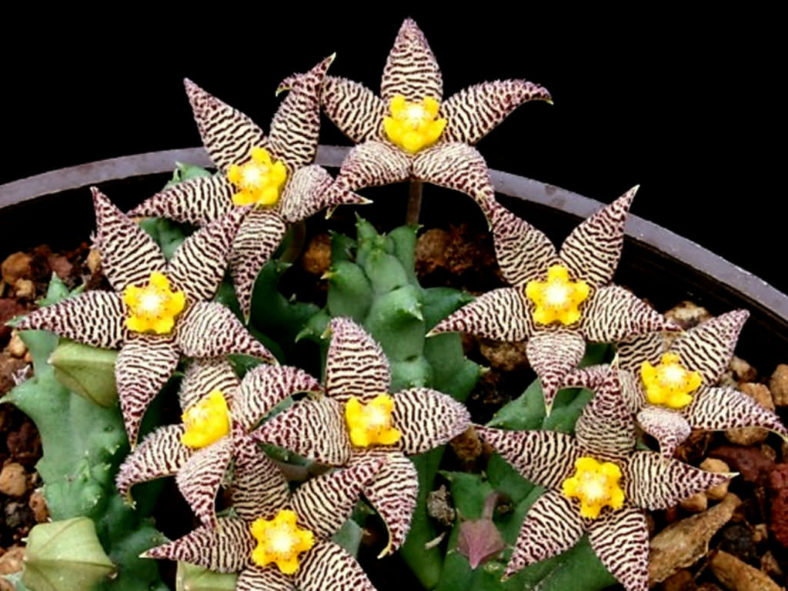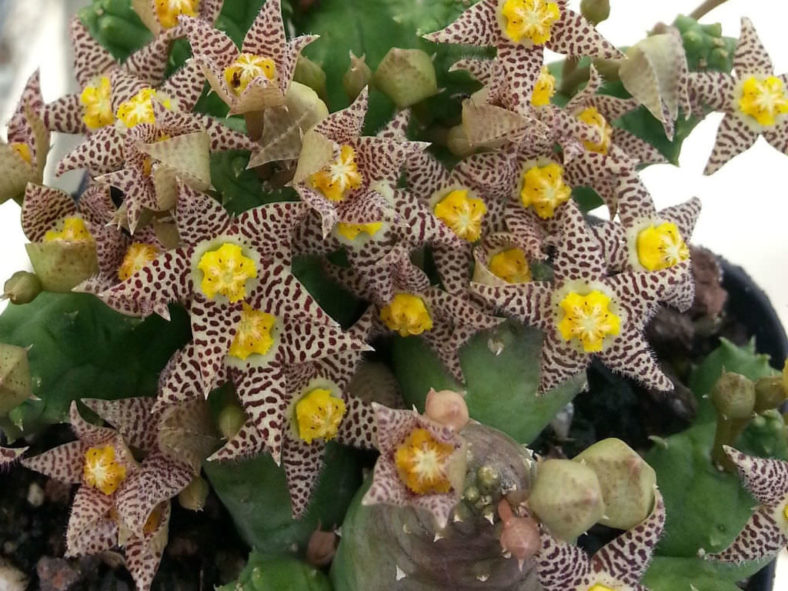Scientific Name
Piaranthus geminatus (Masson) N.E. Br.
Synonym(s)
Caralluma geminata, Ceropegia geminata, Stapelia geminata
Scientific Classification
Family: Apocynaceae
Subfamily: Asclepiadoideae
Tribe: Ceropegieae
Subtribe: Stapeliinae
Genus: Piaranthus
Etymology
The specific epithet "geminatus" (pronounced "jem-in-AY-tus") means "(1) doubled, having been doubled, (2) repeated, having been done again, (3) paired, joined, having been united." It likely refers to the flowers of this species, which often appear in pairs, or to the fruits, which are paired follicles.
Origin
Piaranthus geminatus is native to South Africa. It grows on gravelly and loamy flats under bushes in the Western and Eastern Cape provinces.
Description
Piaranthus geminatus is a dwarf succulent with leafless, pale to dark grey-green, tuberculate stems that spread over the ground, forming a dense mat. The stems are 4- or 5-angled, branched, and typically grow between 0.8 and 2 inches (2 to 5 cm) long, sometimes reaching up to 6 inches (15 cm) in length, and up to 1 inch (2.5 cm) in thickness.
The star-shaped flowers appear in clusters of up to five, opening together at the branch tips in the fall. They can reach a diameter of 1.6 inches (4 cm). The corolla is white, yellow, yellow-green, or brown, transversely marked with red to brown, or rarely uniformly yellow or red-brown. The corona is yellow, sometimes spotted with red. The fruits are paired follicles that can grow up to 0.5 inches (1.3 cm) long.

Subspecies and Forms (not accepted varieties) of Piaranthus geminatus
- Piaranthus geminatus subsp. decorus
- Piaranthus geminatus subsp. geminatus
- Piaranthus geminatus var. foetidus
How to Grow and Care for Piaranthus geminatus
Hardiness: USDA hardiness zones 10a to 11b: from 30°F (-1.1°C) to 50°F (10°C).
Stapeliads are relatively easy to grow. However, they should be treated as outdoor plants as they easily rot indoors and cannot flower without exposure to outdoor temperature fluctuations. Additionally, they should be grown under cover, allowing for controlled watering. Stapeliads require a reasonable amount of sunlight to promote flowering and maintain a well-shaped plant. Very shady positions will produce very poor flowering.
These plants originate from climates where they thrive in extremely high temperatures during the summer, resulting in most growth occurring in spring and fall, with flowering typically taking place in fall as the weather cools down. During the growing season, water is applied in moderation as needed, ensuring the soil is fairly dry between waterings. Do not water between late fall and early spring.
The easiest and most effective way to propagate Stapeliads is by taking stem cuttings virtually throughout the year. Using seeds is also a method of propagation.
See more at How to Grow and Care for Stapeliads.
Links
- Back to genus Piaranthus
- Succupedia: Browse succulents by Scientific Name, Common Name, Genus, Family, USDA Hardiness Zone, Origin, or cacti by Genus
Photo Gallery
Click on a photo to see a larger version.

